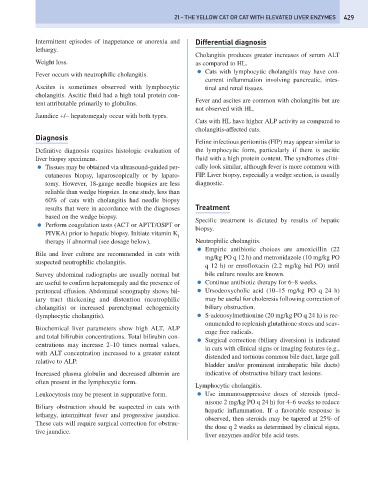Page 437 - Problem-Based Feline Medicine
P. 437
21 – THE YELLOW CAT OR CAT WITH ELEVATED LIVER ENZYMES 429
Intermittent episodes of inappetance or anorexia and Differential diagnosis
lethargy.
Cholangitis produces greater increases of serum ALT
Weight loss. as compared to HL.
● Cats with lymphocytic cholangitis may have con-
Fever occurs with neutrophilic cholangitis.
current inflammation involving pancreatic, intes-
Ascites is sometimes observed with lymphocytic tinal and renal tissues.
cholangitis. Ascitic fluid had a high total protein con-
Fever and ascites are common with cholangitis but are
tent attributable primarily to globulins.
not observed with HL.
Jaundice +/− hepatomegaly occur with both types.
Cats with HL have higher ALP activity as compared to
cholangitis-affected cats.
Diagnosis
Feline infectious peritonitis (FIP) may appear similar to
Definitive diagnosis requires histologic evaluation of the lymphocytic form, particularly if there is ascitic
liver biopsy specimens. fluid with a high protein content. The syndromes clini-
● Tissues may be obtained via ultrasound-guided per- cally look similar, although fever is more common with
cutaneous biopsy, laparoscopically or by laparo- FIP. Liver biopsy, especially a wedge section, is usually
tomy. However, 18-gauge needle biopsies are less diagnostic.
reliable than wedge biopsies. In one study, less than
60% of cats with cholangitis had needle biopsy
results that were in accordance with the diagnoses Treatment
based on the wedge biopsy.
Specific treatment is dictated by results of hepatic
● Perform coagulation tests (ACT or APTT/OSPT or
biopsy.
PIVKA) prior to hepatic biopsy. Initiate vitamin K
1
therapy if abnormal (see dosage below). Neutrophilic cholangitis.
● Empiric antibiotic choices are amoxicillin (22
Bile and liver culture are recommended in cats with
mg/kg PO q 12 h) and metronidazole (10 mg/kg PO
suspected neutrophilic cholangitis.
q 12 h) or enrofloxacin (2.2 mg/kg bid PO) until
Survey abdominal radiographs are usually normal but bile culture results are known.
are useful to confirm hepatomegaly and the presence of ● Continue antibiotic therapy for 6–8 weeks.
peritoneal effusion. Abdominal sonography shows bil- ● Ursodeoxycholic acid (10–15 mg/kg PO q 24 h)
iary tract thickening and distention (neutrophilic may be useful for choleresis following correction of
cholangitis) or increased parenchymal echogenicity biliary obstruction.
(lymphocytic cholangitis). ● S-adenosylmethionine (20 mg/kg PO q 24 h) is rec-
ommended to replenish glutathione stores and scav-
Biochemical liver parameters show high ALT, ALP
enge free radicals.
and total bilirubin concentrations. Total bilirubin con-
● Surgical correction (biliary diversion) is indicated
centrations may increase 2–10 times normal values,
in cats with clinical signs or imaging features (e.g.,
with ALT concentration increased to a greater extent
distended and tortuous common bile duct, large gall
relative to ALP.
bladder and/or prominent intrahepatic bile ducts)
Increased plasma globulin and decreased albumin are indicative of obstructive biliary tract lesions.
often present in the lymphocytic form.
Lymphocytic cholangitis.
Leukocytosis may be present in suppurative form. ● Use immunosuppressive doses of steroids (pred-
nisone 2 mg/kg PO q 24 h) for 4–6 weeks to reduce
Biliary obstruction should be suspected in cats with
hepatic inflammation. If a favorable response is
lethargy, intermittent fever and progressive jaundice.
observed, then steroids may be tapered at 25% of
These cats will require surgical correction for obstruc-
the dose q 2 weeks as determined by clinical signs,
tive jaundice.
liver enzymes and/or bile acid tests.

